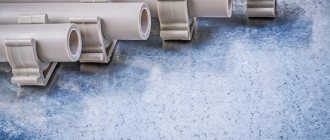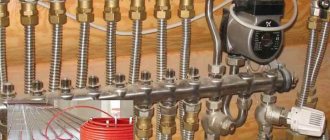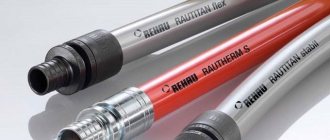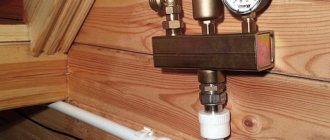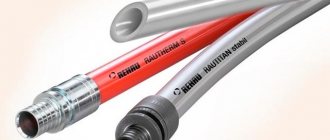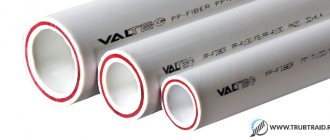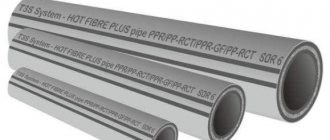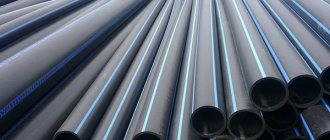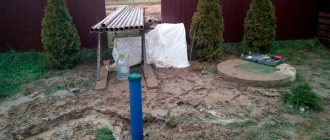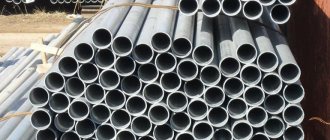A wide range of metals and polymers, as well as various combinations of them, are used in the manufacture of pipes. One of the most common types of products is polypropylene (PP) fiberglass pipe, which has found application in a number of areas of industry and public utilities.
Fiberglass used in the manufacture of pipe products serves as a heat-stabilizing and reinforcing (strengthening) layer. Thanks to the properties obtained, the scope of application of reinforced pipes has been significantly expanded.
Rice. 1 Fiberglass and fiberglass
Properties of fiberglass
Glass fiber is made from different types of glass, including broken glass. The technological process of its production consists of drawing molten glass mass (glass balls in Soviet times) through dies or inflating it with steam when ejected from a centrifuge. With the first method, a glass thread is obtained, and with the second technology, glass wool is obtained.
The resulting fiberglass has the following characteristics:
- Low thermal transfer, which is used in glass wool, the thermal conductivity of which is about 0.05 W/m °C.
- The main characteristic of glass is its increased resistance and neutrality to almost all aggressive chemicals in their high concentrations.
- The density of the glass threads themselves is 2500 kg/m3; when used with other components (plastics, resins) in a combined material, it becomes smaller.
- The melting point of glass depends on its composition and usually lies in the range from 1200 to 1400 °C.
- Glass fiber itself is a non-flammable material, but when mixed with polymers, the overall composite can become a fire hazard.
- Glass is a dielectric and is highly resistant to stray currents.
- Fiberglass is a corrosive and biologically resistant material.
- Glass threads are not inferior in strength to steel, fiberglass is much stronger than nylon.
- Depending on the thickness of the thread, several types of fiber are produced, the ultra-thin has a diameter of 1 micron, the thickest one reaches 25 microns.
Rice. 2 Materials for fiberglass production according to GOST 32650—2014
Technologies for manufacturing fiberglass pipes
The physical and mechanical characteristics of the finished product depend on the production technique. Composite reinforcement is produced by four different methods: extrusion, pultrusion, centrifugal casting and coiling.
Technology #1 - extrusion
Extrusion is a technological process based on the continuous pressing of pasty or highly viscous material through a forming tool. The resin is mixed with crushed fiberglass and a plastic hardener, and then fed into the extruder.
The finished product does not have a continuous reinforcing frame, since the binder is filled with fiberglass randomly. The absence of an armored belt affects the strength of the pipes.
A high-performance extrusion line makes it possible to obtain frameless composite products at a low price, but demand for it is limited due to low mechanical properties. The basis of the polymer matrix is polypropylene and polyethylene.
Technology #2 - pultrusion
Pultrusion is a technology for manufacturing long composite elements of small diameter with a constant cross-section. Passing through a heated forming die (+140 °C), parts made of fiberglass material impregnated with thermosetting resin are “pulled out”.
Unlike the extrusive process, where the determining influence is pressure, in a pultrusive unit this role is played by the pulling action.
The main working units of a pultrusion installation: fiber supply complex, polymer tank, preforming device, thermo-mold, pulling belt and cutting machine
Technological process:
- Fiber threads from spools are fed into a polymer bath, where they are impregnated with thermoplastic resins.
- The treated fibers pass through a preforming unit - the threads are aligned and take on the desired shape.
- The unhardened polymer enters the die. Using several heaters, the optimal mode for polymerization is created and the drawing speed is selected.
The cured product is pulled by a drawing machine and cut into segments.
Distinctive features of pultrusion technology:
- polymers acceptable for processing - epoxy, polyester resins, vinyls;
- broaching speed – the use of innovative optimized “pultruded” polymers allows you to speed up broaching to 4-6 m/min. (standard – 2-3 m/min.);
- working area run-up : minimum – 3.05*1 m (pulling force up to 5.5 t), maximum – 1.27*3.05 m (force – 18 t).
The output is a pipe with perfectly smooth external and internal walls, high-level strength characteristics.
Characteristics of fiberglass produced by pultrusion: breaking stress in bending – 700-1240 MPa, thermal conductivity – 0.35 W/sq.m°C, degree of tensile elasticity – 21-41 GPa
The disadvantages of the method relate not to the quality of the initial product, but to the technology itself. Arguments against: high cost and duration of the production process, impossibility of manufacturing large-diameter pipes designed for significant loads.
Technology #3 - centrifugal casting
The Swiss company Hobas developed and patented the centrifugal forming technique. In this case, production is carried out from the outer wall of the pipe to the inner wall using a rotating mold. The pipeline contains: crushed glass strands, sand and polyester resins.
Raw materials are fed into a rotating matrix - the structure of the outer surface of the pipeline is formed. During production, solid components, filler and glass fiber are mixed into the liquid resin - under the influence of a catalyst, polymerization occurs faster.
As a result, multilayer smooth walls are formed. Thanks to the technology, the pipe structure is monolithic, homogeneous without delamination and gaseous particles
Additional advantages:
- high accuracy of dimensions of the initial product (the internal cross-section of the rotating mold corresponds to the external diameter of the finished product);
- the ability to cast a wall of any thickness;
- high ring rigidity of the polymer composite;
- obtaining a smooth surface outside and inside pipe fittings.
The disadvantage of centrifugal production of fiberglass pipes is energy intensity and high cost of the final product.
Technology #4 - progressive winding
The most popular technique is continuous winding. The pipe is created by alternating the mandrel with fiberglass and polymers with cooling processes. The production method has several subtypes.
Spiral ring technology
The fiber stacker is a special ring, around the circumference of which there are dies with threads.
The working element continuously moves along the axis of the moving frame and distributes the fibers along the helical lines.
When the frame rotation speed changes and the stacker moves, the angle of the glass fibers changes. At the ends of the pipe, the ring operates in reverse mode and lays the threads with a minimum slope
Main advantages of the method:
- uniform strength over the entire surface of the highway;
- excellent tolerance to tensile loads - cracks are excluded;
- creation of products of variable diameters and sections with complex configurations.
This technique makes it possible to obtain high-strength pipes designed for operation under high pressure (pump and compressor engineering networks).
Spiral tape winding
The technique is similar to the previous one, the difference is that the stacker feeds a narrow ribbon of fibers. A dense reinforcing layer is achieved by increasing the number of passes.
The production involves cheaper equipment than the spiral-ring method, but “tape” winding has a couple of significant disadvantages:
- limited performance;
- Loose laying of fibers reduces the strength of the pipeline.
The spiral-tape method is relevant for the manufacture of pipe fittings under low, moderate pressure.
Longitudinal-transverse method
Continuous winding is carried out - the stacker places longitudinal and transverse fibers simultaneously. There is no reverse movement.
Moving coils are used under the rotating mandrel to supply longitudinal reinforcing fibers. When producing bulk pipes, it is necessary to use a large number of bobbins
Characteristics of the method:
- used primarily when creating pipes with a cross section of up to 75 mm;
- there is the possibility of tensioning the axial threads, due to which strength is achieved, as with the spiral method.
Longitudinal-transverse technology is highly productive. The machines allow you to change the ratio of axial and ring reinforcement in a wide range.
Cross-layer cross-longitudinal technology
The development of Kharkov engineers is in demand among domestic manufacturers. With oblique winding, the stacker produces a “veil” consisting of a bundle of connecting threads. The tape is fed onto the frame at a slight angle, overlapping with the previous turn - a ring reinforcement is formed.
Upon completion of processing of the entire mandrel, the fibers are rolled with rollers - the remaining binding polymers are removed, and the reinforcing coating is compacted.
Rolling allows you to achieve the minimum required plastic content. The proportion of glass in the cured composite is about 80% - an optimal result providing high strength and low flammability
Features of oblique knurling:
- density of glass fibers;
- unlimited diameter of produced pipes;
- high dielectric properties due to the absence of continuous reinforcement along the axis.
The modulus of elasticity of “cross-layer” fiberglass is inferior to that of other techniques. Due to the risk of interlayer cracks, the method cannot be implemented when creating pipelines under high pressure.
Production technology
In the pipe industry, the only glass fiber reinforced pipe is polypropylene (PP). Thanks to the technology of introducing an internal fiberglass layer into the pipe shell, the physical characteristics of the products were significantly improved.
Polypropylene pipes reinforced with glass fiber are produced in modern factories using the following technology:
- Granulated polypropylene PPR-100 from the silos in which it is stored is sent to supply bins.
- In the section for preparing fiberglass filler, fiber and polypropylene fibers are formed into bundles under the influence of high temperature. After cooling, they are crushed into granules.
- Granules of fiberglass fiber and polypropylene are conveyed through a pneumatic pipeline into the hoppers of an automated extruder line.
- After molding the pipe shell in the extruder, a three-layer reinforced pipe is obtained at its output.
- Next, the product goes through a vacuum calibrator and cooling baths.
- Afterwards, a caterpillar-type pulling device with a stable pulling speed feeds the pipe to the cutting machine.
- There, dust-free cutting of pipes with knives is carried out into pieces of the required length.
- After cutting, the finished products enter the storage facility, where they are packaged and dumped into transport carts by a pneumatically driven tipper.
Rice. 3 Technology for the production of polypropylene pipes
Polypropylene products
The technical characteristics of glass fiber reinforced polypropylene pipes depend on the polymer used for their manufacture. All products are marked, which makes it possible to immediately determine the areas of use of tubular parts.
Let's find out what the markings on the pipes mean. So, PPR is an English name, and PPR is a Russian name meaning that this is a Polypropylene pipe made from Random copolymer.
Such fiberglass-reinforced polypropylene pipes are used for heating, water supply systems, ventilation systems, and industrial pipelines.
When arranging utility networks, fiberglass-reinforced PPR pipes are increasingly being used. There is nothing strange in this, since they are reliable, quite lightweight, and there are significantly fewer problems with their installation.
Another important factor is cost. For example, the price of PPR pipes reinforced with glass fiber for heating is lower than their metal counterparts, which helps save the family budget. These, as well as other characteristics possessed by fiberglass-reinforced polypropylene pipes, contributed to its popularization and use in various spheres of the national economy.
Areas of application
The main areas of use of polypropylene pipelines are household and municipal services, food and chemical industries. In everyday life they are used for:
- Cold water supply indoors. For these purposes, a conventional PP pipe is used, in which there is no reinforcing layer. However, the use of pipes with fiber in pipelines with high pressure, which is present in networks of multi-storey buildings, cannot be ruled out.
- In hot water lines. PP pipe reinforced with glass fiber is better than others in terms of its technical characteristics and is suitable for intra-house hot water supply networks. It is the optimal choice in terms of price-quality ratio and can withstand a maximum service life at standard pressure and water temperature in the system.
- In heating system pipelines. It is worth noting that polypropylene heating pipes with fiberglass reinforcement are recommended for use in heating systems for both municipal and domestic purposes no higher than 80 ºC and a pressure (PN) of 20 or 25 bar. But not every individual heating system operates with a coolant having a heating temperature of 80 or 90 °C.
Types of PPR pipe reinforcement
To strengthen polypropylene pipes using the reinforcement method, the following materials are used:
- fiberglass is located inside the pipe;
- aluminum can strengthen the pipe walls from the inside or outside, or can be soldered between polypropylene layers.
Both types of reinforced pipes are suitable for installing a heating system in an individual residential building, as well as for connecting to a centralized system. But builders usually prefer fiberglass-reinforced pipes because they are easier to install.
Note! Reinforced pipes are even more durable when reinforced with a composite, i.e. a mixture of fiberglass and polypropylene. This creates a durable structure at the molecular level.
Physical and operational properties
In everyday life, a fiberglass-reinforced PP pipe is used as a heating pipe to supply heating fluid and hot water - this imposes certain restrictions on its physical characteristics and dimensional parameters. Main properties of glass fiber reinforced PP pipes:
- Random polypropylene copolymer PP-R, from which PP heating pipes are mainly made, can withstand temperatures up to 165 °C. In this case, the operating temperature of the environment at which the material can function throughout its entire operational life of 50 years should not exceed 80 °C.
- The polypropylene pipe reinforced with glass fiber is designed for operation at a nominal pressure PN of no more than 20 bar. Some manufacturers (Russian-Italian Valtec) produce PP pipes for 20 bar with a red fiberglass sheath and for 25 bar with sulfur.
- Glass fiber-reinforced PP pipes are connected by soldering, using special soldering irons for polypropylene pipes. The inner and outer shells of the two parts being soldered are heated at a temperature of + 260 °C and joined together. As a result of the mutual diffusion of polymers, a strong and reliable connection is formed. To switch to metal, any production, simultaneously with pipe products, produces a wide range of fittings, many of which are soldered with threaded brass bushings.
- The thermal conductivity coefficient of glass fiber PP pipes is relatively low and amounts to 0.25 W/m °C.
Rice. 5 Areas of application for glass fiber PP pipes from Valtec
- The standard sizes of PP pipes reinforced with glass fiber are determined by their outer diameter from the standard range of 20, 25, 32, 40, 50, 63, 75, 90 and 110 mm.
- The guaranteed and standard service life of PP pipes with fiberglass for heating is at least 50 years, provided they are used in a working environment with the temperature parameters for which they are designed (no more than + 80 ° C).
- The main disadvantage of PP pipes is the high coefficient of linear expansion, reaching up to 9 cm per 100 meters of pure polypropylene. Since the additional layer is a mixture of glass fiber and PP, linear expansion is not significantly affected. Pipe reinforced polypropylene elongates a little less (by 2 - 3 cm) when a 100 m section is heated.
- Like the vast majority of polymers, polypropylene does not tolerate direct solar radiation. To protect against ultraviolet radiation, it is painted in gray, green, and black colors.
- Also, the disadvantages of polypropylene include its high oxygen permeability, which can be harmful for pipelines and heating equipment with parts containing iron alloys.
Rice. 6 Soldering equipment for polypropylene
How elements are connected to each other
PPR pipes reinforced with glass fiber can be joined into a single structure by diffusion welding or fittings (adapters, couplings, tees and other parts).
Each method uses a special soldering iron, the so-called welding machine. The risers joined in this way create a monolithic, non-demountable structure.
The presence of special adapters in the form of threaded or flanged connections makes it possible to fasten a PPR polypropylene pipe reinforced with glass fiber to a metal line corresponding to the fittings.
Fiberglass pipe - installation
The installation of polypropylene pipes with fiberglass reinforcement is no different from conventional ones - to connect individual sections, fittings and fittings, the soldering method is used at a temperature of 260 ° C.
Each manufacturer of fiberglass polypropylene pipes produces a wide range of shaped parts for soldering work. These include couplings, adapters from small to large diameter and from polypropylene to threaded brass, corner bends, tees, shut-off ball valves and a number of other shaped elements.
It is worth noting that for welding fiberglass-reinforced polypropylene pipes, the same fittings are used as for soldering conventional pipes; all fittings are universal.
There are two main types of soldering units for joining polypropylene: sword-shaped and rod-shaped. To work with large-sized elements, disc irons of large diameters are used. Although the price range of soldering irons is quite wide and the market is saturated with a large number of not very high-quality Chinese devices, a good Turkish-made device for semi-professional and household use can be purchased for only 3,000 rubles.
Rice. 7 Fittings, fittings and fittings for soldering polypropylene
The procedure for soldering polypropylene itself does not look too complicated; often, in order to save money, owners master soldering on their own and lay intra-house lines with their own hands.
To connect two polypropylene pipes of the same or different diameters on a sword-shaped soldering iron, carry out the following operations:
- Assemble the soldering device by connecting cylindrical nozzles to it on both sides.
- Plug the soldering iron into the electrical network and wait for the iron to heat up to the desired temperature - this is indicated by the indicator.
- At the same time, place a pipe and a coupling on the nozzles on both sides and hold them for some time, specified in the instructions for the soldering machine.
- Remove the pipe and coupling, quickly join them together, trying to maintain the relative position of the parts strictly along the axial line. Under no circumstances should the parts be rotated relative to each other.
- After fixing for a specified time, the joining of two elements is considered complete.
- Then the entire procedure is repeated, heating the second pipe section and the first with a soldered coupling on the nozzles.
Advantages of polypropylene pipes
Almost everything is made from polypropylene - from films to plumbing parts. Their popularity is due to a large number of advantages.
Among them:
- flexibility. Such pipes can be laid even in the most inaccessible places, since the material itself is very plastic and can take almost any shape. Therefore, they are often used when installing underfloor heating systems;
- strength. As mentioned above, the material itself is hard and resistant to mechanical damage. Accordingly, the polypropylene part has the same advantages. Such communications are not afraid of minor damage;
- durability. A pipe made of this plastic is quite durable and, with proper installation and operation, will last you 50-70 years;
- low price. Compared to analogues made of metal and copper, this product greatly benefits as it has a lower cost. Not inferior to metal products in strength and service life, it is more affordable;
- versatility. Polypropylene pipes are used in various sectors of the economy. It can be used for underfloor heating, insulating and protecting electrical cables, transporting cold and hot water, and also as part of a heating system. The type and size of the building does not matter - such equipment works great anywhere;
- heat resistance. The polypropylene pipe operates quietly at 96 degrees Celsius, which makes it possible to work with hot substances;
- simple design and easy installation. This plus allows you to speed up and simplify the process of installing the pipe, and also eliminates the need to resort to the services of specialists - such a system can be connected independently;
- a light weight. This greatly simplifies the work with the equipment and its transportation.
Installation of polypropylene pipes is carried out in a very simple way, so all work on the installation of the pipeline can be carried out independently
Marking of polypropylene pipes with fiberglass
Polypropylene pipes reinforced with glass fiber are marked by leaving a longitudinal symbol strip on the outer shell.
It is worth noting that the order of arrangement and the presence of certain symbols differ among different manufacturers due to the lack of uniform standards. But any marking necessarily contains the dimensional parameters of the product and its pressure characteristics. Decoding of alphanumeric symbols in order of arrangement:
- Logo, trademark of the manufacturer.
- Product brand name
- Material of manufacture. Usually they use the standard designation - PP-R/GF/PP-R or PPR-GF-PPR (sometimes PPR-GF), where - PP-R is a random propylene copolymer; — GF — inner layer made of a mixture of polypropylene and fiberglass.
- SDR is a standard diameter to wall thickness ratio.
- S - series of pipes, shows the ratio of the outer diameter to the wall thickness. The indicator duplicates SDR and is related to it using the formula S = (SDR-1)/2.
- MRS - minimum long-term strength. It shows at what pressure the pipe can be guaranteed to serve a service life of 50 years, provided that it transports a working medium with a temperature not exceeding 20 °C.
- PN - nominal pressure, consists of the indicated symbol and number.
- Product diameter and wall thickness.
- The operating class is usually assigned to products from domestic manufacturers: - 1 - the product is designed for operation in hot water supply networks at a working environment temperature of no more than 50 °C. — 2 – for use in hot water supply lines at water temperatures up to 70 °C. — 3 – the product is suitable for use in low-temperature radiator heating with a heating fluid temperature of no more than 50 °C. – 4 – the pipe is intended for use in high-temperature radiator heating with a coolant temperature of up to 70 °C. — 5 – the product is designed for use in underfloor heating at a working environment temperature of no more than 90 °C. — HV – pipe is intended for use in cold water supply networks.
- Specifications, normative document or standard.
- Factory information: shift, batch, production date.
- Product barcode.
- Manufacturer country.
Rice. 9 Examples of marking PP pipes
Related article:
Autonomous heating system for a private house - a complete guide . How to properly organize an autonomous heating system, what materials and equipment to choose, how to organize everything correctly, what documents will be needed.
How to choose the right one
This question is asked by everyone who deals with the arrangement of pipe structures during repairs or when building a new house. The main thing is that the planned highway is of high quality and cheap.
To optimally resolve the issue, you need to have knowledge of the technical characteristics of the system that you plan to build.
Experts advise adhering to certain recommendations regarding other characteristics, the main ones being:
- diameter;
- pressure;
- manufacturers.
And then - in more detail.
Required diameters.
Today's market is saturated with products with diameters of 20-110 mm.
In everyday life, elements with a diameter of up to 40 mm are most often used. Risers of this thickness are used in the installation of heating, ventilation systems, hot and cold water supply.
In some cases, the most accurate calculations are needed when installing certain communications. In such situations, it is necessary to use the services of specialists who, using formulas, will make the necessary calculations. Taking into account the maximum water flow rate and the speed of its movement, professionals will tell you as accurately as possible what diameter riser should be used in a given case.
What pressure are the parts designed for?
To a person not familiar with the specifics of such work, the task of choosing a riser that can withstand a certain pressure seems quite difficult. But this is at first glance. In fact, the problem is easily solved.
To do this you need: to know what pressure the heating or plumbing system is designed for and... to be able to read. This means that since all glass fiber reinforced PPR pipes are marked, it contains all the information about the product. That's where it says what maximum pressure the product is designed for.
Mostly, in everyday life, communications with the inscription PN20 are used, which means that the part can be used in lines with a pressure of up to 20 atm. This number is exaggerated, since such pressure is not observed in household lines. For example, in heating systems of one-story buildings, the nominal pressure is 2.5 - 4 atmospheres. But a margin of safety won't hurt.
Regarding the diameter, it is necessary to select the appropriate fittings.
Important! The optimal option for selecting pipes and fittings is to have parts not only of the same diameter, but also of the same manufacturer. When installing a structure made from such elements, minimal problems are eliminated.
Manufacturers
The correct choice of PPR risers also includes the choice of manufacturer. There is no one specific company whose products would satisfy all customers.
The question is to avoid unnecessary problems. Therefore, preference should be given to that (or those) enterprises whose reputation in the market for similar goods is impeccable.
Companies from Europe have a certain advantage in this regard. High quality, reliable operation, affordable price, which means that products from companies from Germany and the Czech Republic are popular.
In recent years, the quality of goods from Turkey and China has increased significantly.
Domestic manufacturers are slightly behind them, whose products today are distinguished not only by relatively low prices, but also by proper quality. The choice is yours. The main thing is not to buy fakes. Therefore, buy goods in branded stores, requiring a quality certificate.
In addition to these, there are other reasons that influence the choice of product. There is, however, one thing: we did not remember at all about the service life of products made from white polypropylene. There is a reason for this. Adhering to the requirements of proper operation, the elements of the pipeline structure are fully capable of withstanding the period of time needed to begin the next major renovation of the building.
These are the materials today.
